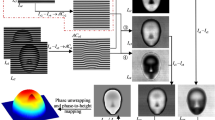Abstract
We have previously proposed a moiré method using the Fourier transform of a fringe or grating line pattern recorded by a TV camera. It performs automated and accurate analysis of displacement, strain, strain rate and height distributions. In the method, the direction of the grating lines before deformation must co-incide with the direction of the scanning lines of the TV camera. In this paper, the method is extended to include the case of misalignment in which the direction of the grating lines is different from that of the scanning lines of the TV camera. By using this method, positioning of the TV camera is simplified because it does not require precise alignment of the TV camera. This method is useful to analyze fringe patterns with carrier fringes that are introduced to aid in the interpolation of brightness distribution.
Similar content being viewed by others
References
Kujawinska, M., “Automatic Fringe Pattern Analysis in Optical Methods of Testing,” Warsaw Univ. Tech. Sci. Rep., (138), 1–80 (1990).
Sirkis, J.S., Chen, Y., Singh, H. andCheng, A.Y., “Computerized Optical Fringe Pattern Analysis in Photomechanics: A Review,”Opt. Eng.,31 (2),304–314 (1992).
Sciammarella, C.A. andSturgeon, D.L. “Digital-filtering Techniques Applied to the Interpolation of Moire-fringes Data,”Experimental Mechanics,7 (11),468–475 (1967).
Takeda, M., Ina, H. andKobayashi, S., “Fourier-transform Method of Fringe-pattern Analysis for Computer-based Topography and Interferometry,”J. Opt. Soc. Amer.,72 (1),156–160 (1982).
Macy, W.W. Jr., “Two-dimensional Fringe-pattern Analysis,”Appl. Opt. 22 (23),3898–3901 (1983).
Bone, D.J., Bachor, H.-A. andSandeman, R.J., “Fringe-pattern Analysis Using a 2-D Fourier Transform,”Appl. Opt.,25 (10),1653–1660 (1986).
Morimoto, Y., Seguchi, Y. andHigashi, T., “Moiré Analysis of Strain by Fourier Transform,”Trans. of JSME (in Japanese),54 (504A),1546–1552 (1988):JSME Int. J. (English translation) Ser. I.,32 (4), 540–546 (1989).
Morimoto, Y., Seguchi Y. andHigashi, T., “Application of Moiré Analysis of Strain Using Fourier Transform,”Opt. Eng.,27 (8),650–656 (1988).
Morimoto, Y., Seguchi, Y. andHigashi, T., “Strain Analysis by Moiré Method and Grid Method Using Fourier Transform,”Comp. Mech.,6 (1),1–10 (1990).
Morimoto, Y., Seguchi, Y. andHigashi, T., “Two-dimensional Moiré Method and Grid Method Using Fourier Transform,”Experimental Mechanics,29 (4),399–404 (1989).
Tanaka, K. andNakajima, M., “Method of Experimental Strain Analysis by Photograting,”J. Jap. Soc. for Test. Mat. (in Japanese),10 (89),116–121 (1961).
Morimoto, Y., Seguchi, Y. and Sasahara, S., “Image Processing for Fourier Transform Moiré and Grid Method (FTMGM),” Proc. 1990 SEM Spring Conf. on Exp. Mech., 353–358 (1990).
Author information
Authors and Affiliations
Rights and permissions
About this article
Cite this article
Morimoto, Y., Seguchi, Y. & Daifuku, K. Fourier-transform moiré method with consideration of misalignment. Experimental Mechanics 34, 349–356 (1994). https://doi.org/10.1007/BF02325150
Received:
Issue Date:
DOI: https://doi.org/10.1007/BF02325150




